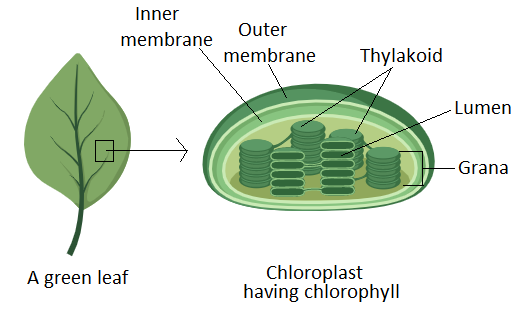
Determine the wavelength at which chlorophyll a shows maximum absorption? Can you determine the wavelength (colour of light) at which chlorophyll shows the maximum absorption? Does it show another absorption peak at any other wavelengths too? If yes, which one?
Answer
555.6k+ views
Hint: Chlorophyll is the main pigment in the plant which gives green colour and helps to conduct the essential process of photosynthesis. It is a chemical pigment that absorbs and reflects a certain wavelength of light. It is found in the thylakoid membrane of the chloroplast organelle of the plant cell. It is of six types but the major ones are chlorophyll a and b.
Complete answer: Chlorophyll is the key component of all the autotrophic organisms. It is the chemical pigment that helps to conduct photosynthesis which is a process of converting light energy into chemical energy. The chlorophyll in plants is responsible for their green colour and their ability to make their own food. It is found in the thylakoid membrane of the chloroplast organelle present in the plant cells.

Chlorophyll absorbs light energy provided by the sun and processes its pigment through pigment until it reaches the reaction centre. Chlorophyll is of 6 types but the main types are chlorophyll a and chlorophyll b. Chlorophyll a is the primary pigment. On the other hand, chlorophyll b is just an accessory pigment. Chlorophyll a is present in all those organisms that perform photosynthesis. It absorbs light in the range of red-violet and violet-blue regions of the electromagnetic spectrum of visible light. Thus, the left light is reflected in our eyes making us see the plant as green in colour. It shows maximum absorbance of light of wavelength 430-470 nm corresponding to blue light and 660-670 nm corresponding to red light. These two wavelengths trigger high rate photosynthesis by chlorophyll a. absorption of the violet colour of wavelength 390-430 nm is an additional peak seen in photosynthesis activity of chlorophyll a. Chlorophyll transfers the absorbed light energy to the reaction centre. Here, it donates two excited electrons to the ETC or electron transport chain. So, it acts as a primary electron donor. After it donates two electrons further transfer takes place and light energy will be converted into chemical energy. This energy is then used by cellular components of the plant to grow and to develop.
Note: The chlorophyll a and b vary in the colour of light they are sensitive to or absorb. Chlorophyll b is sensitive to blue light. Its central role is to expand the absorption spectra for the organism. It enables an organism to absorb more energy available in the blue part of the spectrum of visible light. It is studied that less sunlight has increased levels of chlorophyll b.
Complete answer: Chlorophyll is the key component of all the autotrophic organisms. It is the chemical pigment that helps to conduct photosynthesis which is a process of converting light energy into chemical energy. The chlorophyll in plants is responsible for their green colour and their ability to make their own food. It is found in the thylakoid membrane of the chloroplast organelle present in the plant cells.

Chlorophyll absorbs light energy provided by the sun and processes its pigment through pigment until it reaches the reaction centre. Chlorophyll is of 6 types but the main types are chlorophyll a and chlorophyll b. Chlorophyll a is the primary pigment. On the other hand, chlorophyll b is just an accessory pigment. Chlorophyll a is present in all those organisms that perform photosynthesis. It absorbs light in the range of red-violet and violet-blue regions of the electromagnetic spectrum of visible light. Thus, the left light is reflected in our eyes making us see the plant as green in colour. It shows maximum absorbance of light of wavelength 430-470 nm corresponding to blue light and 660-670 nm corresponding to red light. These two wavelengths trigger high rate photosynthesis by chlorophyll a. absorption of the violet colour of wavelength 390-430 nm is an additional peak seen in photosynthesis activity of chlorophyll a. Chlorophyll transfers the absorbed light energy to the reaction centre. Here, it donates two excited electrons to the ETC or electron transport chain. So, it acts as a primary electron donor. After it donates two electrons further transfer takes place and light energy will be converted into chemical energy. This energy is then used by cellular components of the plant to grow and to develop.
Note: The chlorophyll a and b vary in the colour of light they are sensitive to or absorb. Chlorophyll b is sensitive to blue light. Its central role is to expand the absorption spectra for the organism. It enables an organism to absorb more energy available in the blue part of the spectrum of visible light. It is studied that less sunlight has increased levels of chlorophyll b.
Recently Updated Pages
Master Class 11 Economics: Engaging Questions & Answers for Success

Master Class 11 English: Engaging Questions & Answers for Success

Master Class 11 Social Science: Engaging Questions & Answers for Success

Master Class 11 Biology: Engaging Questions & Answers for Success

Class 11 Question and Answer - Your Ultimate Solutions Guide

Master Class 11 Business Studies: Engaging Questions & Answers for Success

Trending doubts
10 examples of friction in our daily life

One Metric ton is equal to kg A 10000 B 1000 C 100 class 11 physics CBSE

Difference Between Prokaryotic Cells and Eukaryotic Cells

1 Quintal is equal to a 110 kg b 10 kg c 100kg d 1000 class 11 physics CBSE

Explain zero factorial class 11 maths CBSE

What is a periderm How does periderm formation take class 11 biology CBSE




